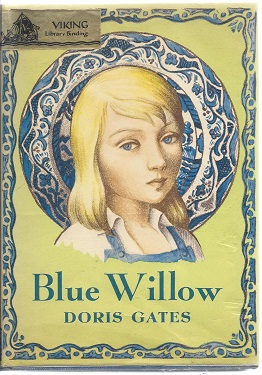Blue Willow facts for kids

First edition
|
|
| Author | Doris Gates |
|---|---|
| Illustrator | Paul Lantz |
| Country | United States |
| Language | English |
| Genre | Children's novel |
| Publisher | Viking Press |
|
Publication date
|
1940 |
| Media type | Print (Hardcover) |
| Pages | 172pp |
Blue Willow is a realistic children's book written by Doris Gates. It was published in 1940. This story was so important that it was named a Newbery Honor book in 1941. The author, Doris Gates, was a librarian who worked with children whose families moved often for work. This book tells the story of a girl who dreams of having a permanent home. It was special because it showed the real lives of working families in America at that time.
Story of Janey Larkin
Janey Larkin is a ten-year-old girl. She lives with her family in the San Joaquin Valley in California. This was in the late 1930s, when America was still dealing with the Great Depression. This was a time when many people lost their jobs and homes.
Janey's most special thing is a Blue Willow plate. It used to belong to her great-great-grandmother. The plate has a picture of a bridge, a stream, and a small house. This picture shows the permanent home Janey dreams of having.
Janey can barely remember her old home, a farm in Texas. Now, her father is a worker who moves from place to place. This means Janey has no real home of her own. She also can't make lasting friends because her family is always moving.
Even though they are very poor, Janey's family is close and loving. They still find ways to have fun. Janey and her friend Lupe go to the county fair. The whole family also enjoys fishing by the river.
Later in the story, Janey's mother gets sick. This makes it very hard for the family to pay their rent. The person who collects the rent, Bounce Reyburn, is not kind. Janey then faces a tough choice. She might have to give up her one special treasure, the Blue Willow plate.
What the Blue Willow Plate Means
Janey's blue willow plate is her most prized possession. It belonged to her great-great-grandmother. The plate reminds Janey of her birth mother, who died when Janey was very young. This delicate plate holds both Janey's past and her hopes for the future.
For Janey, the plate stands for the home she had before her family lost their land. It also shows her hope for a better life and a real home. When Janey nervously shows the plate to her friend Lupe, Lupe understands how important and beautiful it is. This moment makes their friendship stronger.
Why This Book Is Important
Blue Willow is known as one of the first "realistic problem novels" for children. It was well-liked, but some people criticized it because of its serious topic. Janey Larkin became a symbol for those who believed children's books should be realistic.
When the book came out, there was a big discussion. Should children's books be mostly about imagination, or should they show real life? Blue Willow actually combines both. The story's setting is very realistic, showing the tough lives of migrant workers. But Janey's strong love for the plate and the home it represents comes from her ability to dream. She can look beyond her difficult life and believe in a better future.
Blue Willow was seen as a book with great writing and good values. Librarians and teachers liked it, and children enjoyed reading it too. It was a breakthrough book because it showed contemporary working-class life. It also gave a full and real picture of Janey's Mexican-American friend, Lupe Romero, and her family. Because Blue Willow was so successful, it helped open the door for more kinds of topics to be explored in children's books.
Some writers who focused on realism preferred to set their books in other countries or in the past. They might have done this to avoid talking about current social issues. However, Doris Gates was one of the few exceptions. She wrote about modern problems and thought them through honestly.

